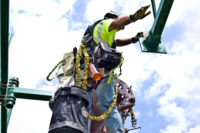It’s important to be hands-free when climbing to at-heights work

Hands-free is a popular concept in communications safety. Theoretically, drivers can maintain full concentration and control when they have both hands on the wheel and aren’t clutching a cell phone in one hand.
Moving from one place to another with free hands can also prevent worksite falls. Most workers were trained to climb with the “Three Points of Contact Rule”1 in mind. That is, keeping both feet and one hand (or both hands and one foot) in a stable position while one hand or foot is in motion. So both hands are free to grasp and hold railings or ladder rungs. The practice is fundamental for climbing to work at elevation or any place with railings.
Those who work with their hands usually have something in their hands. So they need a way to carry their stuff – tools, equipment, lunch and hydration – to and fro on their job site. While this isn’t typically a problem for travel on smooth surfaces, not all walking/work surfaces are smooth, level, uniform or horizontal.
Shifted standard
OSHA recognized this when the federal agency revised its Walking-Working Surfaces and Fall Protection Standards:
"Falls from heights and on the same level (a working surface) are among the leading causes of serious work-related injuries and deaths. OSHA has issued a final rule on Walking-Working Surfaces and Personal Fall Protection Systems to better protect workers in general industry from these hazards by updating and clarifying standards and adding training and inspection requirements.
“OSHA estimates that these changes will prevent 29 fatalities and 5,842 lost-workday injuries every year.”2
A key component of this standard points to the importance of climbing technique in safety, tying back to the “Three Points of Contact Rule.” The requirements in section §1910.23 Ladders state:
- (11) Each employee faces the ladder when climbing up or down it;
- (12) Each employee uses at least one hand to grasp the ladder when climbing up and down it; and
- (13) No employee carries any object or load that could cause the employee to lose balance and fall while climbing up or down the ladder.
Worksite surfaces can be sloped (roofs), elevated (scaffolds or catwalks), subterranean (utility vaults), or even vertical (towers, utility poles and suspended) and may require a climb to access. With these circumstances in mind, how do you transport your tools and gear while following the “hands-free” technique called out in OSHA standards?
Bucket list
The answer? In hoist buckets, topped tool pouches and tool holsters. Items such as backpacks, totes, standard tool belts and toolboxes have their place for storing and transporting tools, gear, supplies, and more. But none are designed for at-heights transport or use. Properly selected and used, at heights containers inherently contribute to dropped objects prevention schemes (DROPS), fall protection, and improved workplace organization.
Toolboxes are great for organization, but most are designed to stay on the ground, in a truck or on a workbench – not to fly. Hoist buckets are designed to be lifted into the air without losing their load. With designs and materials that have been updated to meet modern safety requirements and program elements, it’s fall protection for your tools and gear.
Topped tool pouches and tool holsters are designed to be stationary containers attached to worker fall protection harnesses, tool belts, or the structure being worked on. They are specifically designed for holding different tools and hardware, and keeping these things accessible while also preventing spillage of their contents. They should have D-ring tethering points for attaching tool lanyards.
The design of the hoist bucket, topped tool pouch, and tool holster must be engineered to support the intended load. The entire bucket, pouch, or holster must be load-rated and tested as a system, preferably by an independent third-party, with a high confidence safety factor (5:1) – that means a bucket rated to carry 100 pounds (45 kilograms) has been tested to 500 pounds (227 kilograms) without failure.
Take cover
When used at elevation, it's important to keep the contents of the bucket or tool pouch stay inside, so some type of top, cover or closure is also recommended. If the container does not have a cover or closure, tethering points are necessary. The bucket or tool pouch cover should meet the following criteria:
- The cover has to be secure when closed and fastened.
- It has to retain the contents if the hoist bucket or pouch is accidentally tipped or inverted.
- It has to be convenient to secure and remove, even while wearing gloves or working under challenging environmental conditions.
- The cover itself should not create a falling object hazard when opened.
- It should be statically tested inverted at a 2:1 safety factor, so a bucket rated to 100 pounds (45 kilograms) will be tested inverted at 200lbs (91 kilograms).
Inspect to protect
Regular inspection of at-heights containers, ropes and cables, fall protection and other at-heights workplace gear is necessary for excessive wear or damage. Cuts, holes, missing stitching, and fraying should be reported to a supervisor for further evaluation. Hardware components like D-rings or carabiners should operate smoothly and be corrosion-free.
Conclusion
Defined by their simplicity, appropriate containers can take workplace organization to the next level. That improves housekeeping, inventory management, and most importantly, safety. The proper containers prevent dropped objects and give workers free hands to climb safely following updated industry regulation and best practice. It’s a recipe for productivity.
This article is an excerpt from an Ergodyne white paper. Since 1983, Ergodyne has worked on the development of products that Make The Workplace A Betterplace™.
References
- Basic Ladder Safety; American Ladder Institute http://www.americanladderinstitute.org/?page=BasicLadderSafety
- Final Rule to Update General Industry Walking-Working Surfaces and Fall Protection Standards; OSHA – U.S. Department of Labor https://www.osha.gov/walking-working-surfaces/index.html
- Final Rule to Update General Industry Walking-Working Surfaces and Fall Protection Standards; OSHA – U.S. Department of Labor. §1910.23 Ladders https://www.gpo.gov/fdsys/pkg/FR-2016-11-18/pdf/2016-24557.pdf
Looking for a reprint of this article?
From high-res PDFs to custom plaques, order your copy today!





